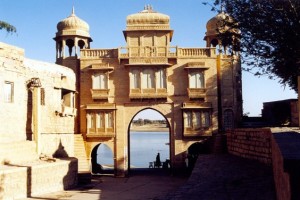The Worlds Strangest Bridges
 Bridges don’t belong anywhere. By definition, a bridge has two ends anchored in reality and a middle that floats in space. This deflection of the real world has inspired some artists to get creative. Here are some of the strangest bridges in the world.
Bridges don’t belong anywhere. By definition, a bridge has two ends anchored in reality and a middle that floats in space. This deflection of the real world has inspired some artists to get creative. Here are some of the strangest bridges in the world.
Color, in a place where color is unexpected, startles and pleases those who see it. What used to be an ordinary railroad bridge in Wuppertal, Germany was changed into a joy of color by a street artist called Megx. He used a giant Lego as his inspiration. Megx painted the concrete supports the colors of the universally known toys made by a Danish company and included representations of the pillars and holes in each Lego piece. For added realism, Megx installed round structures on the walkway above the bridge to represent pillars on top of the highest Lego.
The Ferris Wheel Bridge
Designers need something extra in a bridge in China to make it stand out from the rest. In Tianjin, China, the bridge architect added a vertical strut to the arch that supports the bridge over the Haihe River and put a 394 foot tall Ferris wheel at the top of the strut. The Ferris wheel appears to be as wide as the bridge itself. Called the Tianjin Eye Bridge, it’s actually the fourth bridge in China to feature a Ferris wheel. The others are the Changsha Ferris Wheel, the Suzhou Ferris Wheel and the Zhengzhou Ferris Wheel. They’re not just decorations. Each is a fully functional carnival ride. The Tianjin Ferris Wheel carries 48 passenger capsules, each with eight passengers. A rotation of the wheel takes thirty minutes which allows the Tianjin Ferris Wheel to take 768 passengers on a ride every hour.
The Ferris Wheel for Boats
Administrators in Falkirk, England had their choice. They needed to reconstruct a canal linking the Union Canal with the Forth and Clyde Canal. The canal had fallen into disuse in the 1930’s and local towns and construction companies had filled it in and sold houses on it. The planners wanted a way to connect the canals that avoided the 11 locks that had been used when the canal was originally built. They still had to lift boats 79 feet from the level of one canal to the other. They designed and built a giant tub at the end of two arms. Boats steer into the tub, the arms rotate and deposit the boat into the other canal. The arms are counterbalanced by arms located on the other side of the axle. Both arms together form the shape of a Celtic axe.
The Invisible Bridge
Bridges should be above whatever chasm they’re arching across, shouldn’t they? Not necessarily. The Moses bridge taking visitors across a shallow moat ringing Fort de Roovere, 17th Century Dutch fort in Halsteren, the Netherlands, dips below the surface of the water. The fort was part of a series of fortifications built by the Dutch to defend against invasion by the French and the Spanish. The water in the moat is kept at the same depth year round. The bridge stays below ground as it leads down one side of the moat, across the water and up the other side. The top of the walkway is no more than three inches above the waterline in the moat.
The Trampoline Bridge
Whimsy has a place in bridge building. The design firm, AZC, in Paris has proposed a bridge that would make it exciting to get from one side of the Seine River to the other. The bridge would consist of three huge trampolines, each 30 meters across, strung together by cables. The trampolines would have giant bolsters on the sides to keep the people out of the river.
The Tilting Bridge
Boats and bridges don’t usually get along. One spans a river a such a height as to be an obstacle to the other. The Harlinger Vaart River bridge solves the problem with two arms attached to a section of the roadway across the river which hinge and lift up the road section. The two arms are counterbalanced by a huge weight at the other end of the arms. The bridge works automatically, sensing a change in the river below and tilting up in the air.


